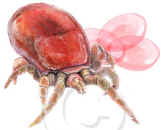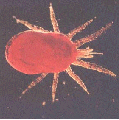|
RED MITE
Things you maybe
didn't but should know about them!!
 
Red Mite
is an obligatory
blood-feeding ecto-parasite
-
It attacks resting birds, mainly during the night
for a short (1 - 2 hours) blood meal.
-
After feeding, the mites hide in cracks and crevices
away from daylight.
Red mites are
very small
-
just visible without magnification
-
Red mites are not species specific and
will "attack" any species or breed of bird.
-
They do not fly nor are they usually
transmitted via clothing
-
although if there is a bad
infestation, mites have been known to "jump" onto a person's
clothing
and therefore could be transported this way to another
location/Aviary etc.
-
Remember they are only usually out
of their hidey-holes towards dusk/dark and would be unusual
for them to
be active during daylight hours.
they are extremely mobile considering
their microscopic size
and can travel great distances
relative to their size! -
They can be transferred from bird to
bird
-
or from wild birds landing on your
Aviaries,
-
Adults - are red
when engorged with blood
-
Life cycle
(stages)
Female mites deposit eggs (after a
blood meal) in crevices, -
under boards, at the ends of
perches where they butt up to the back of the cage
-
or in debris near
roosts
-
Under warm conditions the eggs
can transform into :
-
Six-legged larvae within 2
-3 days
-
These 6-legged larvae do not
feed
-
Within 24 hours the larvae moult
into 8-legged protonymphs - which do feed
-
Protonymphs start to feed on roosting birds
-
They then moult into deutonymphs
-
which continue feeding
-
before becoming an Adult Male or
Female Red-Mite
Site of
infestation
-
Skin of the host, but most of the
life cycle is spent in hiding places
-
in the nest, Aviary, cage,
perch-end or roost crevices.
Pathogenesis/clinical
signs
-
If the levels
of infestation are high, the mite can cause increased stress to the
birds - including :
-
Anaemia, due
to blood loss
-
Severe skin irritation
-
Blood loss can cause increased
susceptibility to disease
-
or may be severe enough to cause
death
-
Clinical signs include restlessness,
-
scratching, usually around the head
with the foot
-
or rubbing the head and face on
perches (more often than usual)
-
The mites can occasionally bite
mammals, inc. humans,
Diagnosis
-
A
large infestation will causes anaemia amongst small birds.
-
they can be especially dangerous to small chicks in the
nest.
-
Mites may be difficult to find on the
bird during daylight hours.
-
Look for mites in their hiding places
during the day with a magnifying glass,
-
If you suspect you have Red-mite, hang
a piece of white cloth/white sheet over the front of your cage
and in the morning you
will find blood-red mites (as they will have just fed)
-
Check for tiny black spots - the
mite's droppings
Control
measures
-
An ideal alternative to wood, is to
construct Aviaries/cages for birds
-
out of Plastic &/or metal
-
Plastic "Quicko" cages
and metal (aluminium-panelled) Aviaries
-
thus eliminating
crevices (hiding places) as much as possible.
Seal as many
joints & crevices of your Cages, Aviaries, Nestboxes & Feeders as
possible Use "Painters'
Mate" mastic (that sets hard) or
similar (you can get it in brown) Red mites are able to survive rigorous cleaning and disinfections
programmes Heat guns have been used to some effect on the joints
and crevices of wood-work. Steam cleaners (no birds in the Aviary at the time!) Synthetic Pyrethroid (Cypermethrin) Pyrethroid (alphacypermethrin) Permethrin and Piperonly Butoxide
Silica-based products Citrus extracts
FLYCAM W (Recommended by DEFRA for
Poultry Farmers to eradicate Red Mite from their Flocks
- apparently
very effective - comes in powder Form and can be diluted to spray).
IVERMECTIN "spot-on" is one of the
most effective preventative and eradicating measures you can take.
It works in a similar way to
"Frontline" which you can buy to put on your dogs and cats
to worm
them and kill off fleas etc.
Ivermectin works systemically i.e. it is
absorbed thru the skin or feather shaft into the birds body. So, it follows that it also will be absorbed into
your body thru your skin if you get it on you.
Catch up your bird and blow the feathers apart at
the back of it's neck where it can't get it's beak
to preen. Put one or 2 drops (check directions first so you
do not overdose) on the back of the birds neck,
as near to the skin as
poss. Give it a few seconds to start to absorb b4 letting
the bird go.
IVERMECTIN controls and helps to kill both internal
(worms) and external (mites and lice etc.) parasites. You can get
"Panomec" from your Vets Some Pharmaceutical firms are now supplying a 1%
solution which can be sold over the counter.
Duramitex - is a solution you can use
- You dilute with water and sprayed into all the crevices and hiding places. You can use 1 litre plant spray or empty and rinse thoroughly a kitchen cleaning
spray bottle and fill with the mix. Remember it's better to try and spray towards
dusk/dark to try and get the Red Mite as they emerge from
their hiding places
Remove your birds FIRST BEFORE SPRAYING! You can buy this product from Pet stores or Bird
Shows. Wear a protective mask over your nose and mouth
when spraying. It can't be healthy breathing it in! Also, rubber gloves It's very strong smelling, so don't take any risks
Feeding your bird Garlic (helps
deter mites)
It works by exuding a strong garlic smell thru the
birds skin, which the mites and other biting insects don't seem
to like (your can buy pure Garlic powder or
granules from Agricultural merchants or Saddlers) Add it to a soft food such as Egg Food &/or sweetcorn
Eucalyptus leaves/branches in the Aviary is supposed to help to
deter Red-Mites
It has been rumoured that having Zebra Finches in the
Aviary seems to have help get rid of them
One theory is that they eat them The other theory is that when the Red-mite suck the
Zebra's blood it is toxic to them and kills them Not sure which, if any is true - but worth trying - if you have a small-bird Aviary where the Zebra Finch would fit in with
the other birds. Just remember tho. if you are breeding in an
Aviary, Zebras are noted for building a nest on top
(i.e. inside) of any
other birds nest, on top of eggs too, if there are any in there.
Directions for use - Red Mite
Concentrate or any Anti-mite spray preparation :
-
Red mite is a nocturnal creature so itís best to
spray the birds at night.
-
Check the preparation you are using is safe to use on
birds or NEAR to birds
-
Dim the lights as low as practically possible to avoid
any undue agitation amongst the birds.
-
Donít forget that red mite can live away from the
bird for up to 36 weeks.
"GRANDAD'S" Tried & Tested Red-Mite deterrents
-
Paint Paraffin into the cracks and crevices with a small
paintbrush
-
Mix Paraffin with Vaseline and smear in Cracks and crevices
+ Nest pan bases
-
Use Carbolic Soap in the same way you would use the Paraffin
& Vaseline
-
Double-sided sticky tape over cracks and crevices
-
Coca Cola - the coke sticks to them and the Acid in
the coke breaks down the Red Mite's outer shell,
killing them.
Ever wondered what's in an insect spray?
- and what drives those annoying insects away?
- Well, read on . . .
- One of the most common substances used in insect spray is called
Pyrethrum is often used on clothing,
tents etc.
- There are also several natural insecticides
- like citronella, oils of cedarwood, lemongrass, peppermint,
eucalyptus, soya bean oil, garlic
and many more.
- Blood sucking insects are attracted to many chemical and physical factors,
including carbon dioxide,
body heat, chemicals in sweat, and on the surface
of skin
- Insect bites can be annoying for the itching they cause but they can also
be harmful by transmitting
certain diseases to humans and birds.
- Pyrethrum is a powerful, rapidly acting
insecticide
- similar in structure to natural Pyrethrum insecticide, which is
the natural active ingredient in many flea repellants for dogs, cats as
well as birds.
- The natural Pyrethrum is safe to use on and around your birds.
- It is derived from the crushed and dried flowers of the Daisy
Chrysanthemum (cinerariifolium).
- Permethrin is a human-made synthetic pyrethroid.
- It works as a "contact insecticide"
- causing nervous system toxicity to the insect after it inhales it
- this leads to the death or "knockdown" (out of the air) of
the insect.
- The chemical is effective against mosquitoes, flies, ticks, and mites.
- Permethrin has low toxicity in mammals,& is poorly absorbed
by the skin
- Pyrethrum should be applied directly to clothing or other fabrics such as
tent walls or mosquito nets,
not to skin.
- It remains active for quite some time as a deterrent, if applied to
surfaces.
^
Top

|



